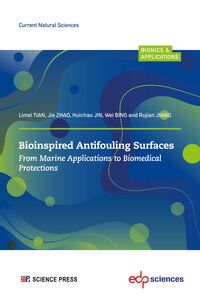
Bioinspired Antifouling Surfaces
From Marine Applications to Biomedical Protections
Limei TIAN
Jie ZHAO
Huichao JIN
Wei BING
Rujian JIANG
Biofouling on marine vessels and bacterial growth on biomedical surfaces bring huge economic loss to our society. Traditional antifouling and antibacterial surfaces contain toxic substances or antibiotics, which can threaten the environments and raise the risk of inducing drug-resistance strains. In the long-term evolution process of natural organisms, they present multiple functions through the joint action of their own morphology, structure, and other factors to achieve the maximum adaptation to the environment. Many of natural organisms have developed antifouling and antibacterial strategies. Inspired by these strategies, lots of artificial surfaces have been fabricated and tested. They are highly efficient and environmental-compatibility, and they have potential to achieve enhanced antifouling capabilities and desirable properties by combining the characteristics of novel materials.
This book focuses on the research and application of bioinspired antifouling surfaces in the two major fields—marine industry and biomedical field. It is intended for mechanical manufacturing and biomedical researchers, professionals and students.
Book details
-
Publisher
-
Language
English -
Publication date
-
Page count
162 -
Theme
-
Collection
About the author
Limei TIAN
Prof. Limei Tian received her PhD degree from JLU in 2005, and then she worked at the Key Laboratory of Bionic Engineering (Ministry of Education), JLU. From 2011–2012, she worked at the University of Manchester, UK as a visiting scientist. She has been working as the Secretary-General of the International Society for Bionics Engineering Youth Committee since 2016. Her current research interest focuses on the development of functional bionic surfaces that have drag reduction and antifouling properties. Based on the above research, she obtained 12 projects and nearly 20 million RMB, including the China National Natural Fund and other provincial-ministerial projects. She has published more than 50 papers in Material Sci. and Eng. C, J. Bionic Eng., Bra. Soc. Mech. Sci, etc., with 20 Chinese or international patents applied or authorized.
Jie ZHAO
Prof. Jie Zhao received his PhD from Changchun Institute of Applied Chemistry Chinese Academy of Sciences in 2011. He moved to the USA afterward and worked at Georgia Southern University as a postdoctoral researcher. He has been a professor at Jilin University since 2016. His research focuses on bio-inspired surfaces, anti-fog coatings, and antibacterial coatings. He has published 40 SCI papers with more than 1700 citations. Currently, he has an h-index of 16 (Publons).
Huichao JIN
Dr. Huichao Jin received his PhD degree in physics from Jilin University (JLU). He is currently an assistant researcher in JLU. His research focuses on functional surfaces, bioinspired antifouling coatings, and medical antifouling materials.
Wei BING
Dr. Wei Bing received her PhD degree from JLU in 2016, and then she joined Changchun University of Technology. She has conducted her postdoctoral studies in Jilin University since November 2017. Her research interests include biomimetic surface, antifouling films, bactericidal materials, biocatalysis and photodynamic therapy for environmental and medical applications.
Rujian JIANG
Doctor of Engineering
Shandong First Medical University & Shandong Academy of Medical Sciences · Science and Technology Innovation Center, School of Chemistry and Pharmaceutical Engineering






